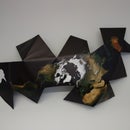Introduction: IKEA Shelf Safe With Magnetic Key
Step 1: ITEMS and TOOLS
You will need a few items:
1. Lack wall shelf from ikea (10$)
2. 2 screws to install the shelf (not included with the shelf)
3. Wall anchors for installing the shelf (unless your wall studs are 8 3/4 inches apart)
4. Scrap fine grained particle board 1 foot by 1 foot (1/8 inch thick). You can use the backing of an old picture frame.
5. Two old hard drives (or 4 Neodymium magnets)
6. Musical Birthday Card (for the alarm)
For this project you will need a few workshop tools:
1. Drill with bit wider than 0.5 inches
2. Jigsaw
3. Wood glue
4. Glue gun
5. Screwdriver
6. Vice
7. Set of Torx screwdrivers
8. Safety glasses
9. Small clamps
Step 2: Create Your Opening
The engineers at IKEA are geniuses: they produce these bulky light and surprisingly sturdy items for way less than you could make at home. If you don't believe me, then try building this for 120$ (well you actually have to build it either way...). They make some of their furniture seem bulkier than it seems by literally filling it with air. For the LACK series they use corrugated paper to provide some stiffness.
CAUTION: You will be using power tools here, it is always better to protect yourself rather than spend half a day in line at the hospital (for you fellow Canadians) just to get a piece of sawdust out of your eye, or stitches on your finger. Use appropriate safety gear and be careful.
DOUBLE CAUTION: This shelf is build very cheaply meaning you will easily scuff, chip and buckle it. Pay particular attention when retracting the jigsaw as the blade will continue to reciprocate after you let go of the trigger and could do some serious damage to the finish. I ended up turning the brackets around because I had chipped the top side of the shelf.
Before drill you should remove the sticker from the back of the shelf and save if for later.
The goal is to make a very clean rectangular hole in the back of the shelf. We want to leave enough material on either end so that the wall brackets are very secure, and we don't cause the shelf itself to collapse. I centered a gap of 5 and 1/4 inches. To start, drill two big drill holes at the extremities of your planned opening. Then use your jigsaw (use a long and fine blade if possible) to cut the hole to your plan. Try to get the cut as square as possible because you want the safe door to be snug as a bug. I ended up using the jig saw fairly aggressively to scrape some of the particles and glue from the inside of the shelf; again be very careful to not scuff or chip the finished surfaces.
You can use a pocket knife or screwdriver to cut the corrugated paper loose from the top and bottom of the shelf then simply push the paper down and to the sides with your hand to make the hole the desired size.
Step 3: Make a Seat for the Door
Make sure that you have cleaned up the glue and crud as well as possible along the top and bottom, because we will be gluing some pieces of particle board so that the lid can sit without falling into your secret compartment.
Cut two lengths of the fine grained particle board into strips of 1/4 inch and around 5 inches long. The jigsaw works very well on his type of soft material. Glue them on the inside of the shelf providing just enough space for the lid to fit in and be recessed with respect to the original particle board on either end. In my case the top of the strips were 3/4 of an inch from the back edge of the shelf. Try to use the original edge from the board on top, because it is straighter than you or I can cut (no offense). I used wood glue and 2 clamps on either side to hold the pieces snugly. Be careful not to over-tighten the clamps, as the outside surface is easily crushed and scratched.
Step 4: The Door
If you executed step 2 like a pro (cutting a perfect rectangular hole), then this step will be much easier. Measure the hole very precisely and trace onto the particle board by using a straight edge. Cut it out using the jigsaw.
Resist the temptation to push it completely in the opening, otherwise you soon will be looking for a knife to jimmy it out. Test the size by testing the individual edges of the door one at a time (pinch the door between you thumb and fore finger on front and back). You want the fit to be tight but not submarine tight. If you think that you are very close, then you may be able to gain a few micrometers by gently scraping the inside of the opening with a knife, otherwise trim the door with the jigsaw or sand it.
Transfer the IKEA label onto the new door to give it a little more authenticity.
Step 5: Harvesting Magnets
I copied this section from Cake-Icing-Tracer-Projector instructable:
Warning, these magnets are VERY powerful and could pinch your fingers or break if you let them snap into each other. I removed about a dozen in an afternoon, and was paranoid that they would start self agglomerating on the table in front of me...
The average household should have 3 old computers gathering dust, if you don't then someone you know does. They are unlikely to be worth anything, so you can go ahead and recycle them; but first, pull out the hard drives and harvest the magnets. All you need is a set of torx screwdrivers (which look like a six pointed star), and maybe some Philips head drivers as well depending on the brand of hard drive. Take off the cover by removing all the screws as well as a few that are likely hiding under stickers or labels. If the cover is not coming off then you likely missed one; rub the labels with the tip of the screwdriver until you find the divot where that last screw was hiding. Once you have the cover off you should find a metal bracket in one corner near the axle for the reader head (see the images). Remove any screws that may be holding the bracket in place and pry off the bracket. It will likely take a screwdriver to get it off because the magnets are very strong. Once you have removed the first magnet, you will see a second one looking back at you. Remove any screw and extract this one too.
Now we need to separate the magnet from its bracket. Secure the bracket securely in a vice while being careful not to squeeze the magnet, remember they are brittle. Gently pry the magnet off with flat screwdriver.
Step 6: MAG LOCK AND KEY
I used a glue gun to stick the magnets to the back of the door near the ends. I had initially considered using some mildly magnetic screws on the inside of the safe so that the door would stay shut magnetically; the strength of the magnet key would overpower the attraction to the screw inside releasing it. My door was sufficiently tight that I didn't feel it necessary, but if your door is not snug then this is good solution. If it the magnetic attraction keeping the door shut is too strong then you can move the screw further or put layers of tape to increase the distance.
I was fortunate that I had two great tins that were perfect for dissimulation of the Nd Magnet (keys). I did not need to glue the magnet in either case. You can also stick the magnets inside or under any number of items that would be stored on or near the shelf.
Step 7: Alarm System
OK I know what you're thinking: "you'll have to be in the same room as the burglary for that alarm to be heard". You would partially right and a little surprised: it is loud enough to startle any potential stash hunters.
You can find musical cards in any place that sells birthday cards, they usually sell at a slight premium. I have recieved a few of them over the years and I have been saving them for just such an occasion. You only need to carefully peel the chip and speaker from the card and use a glue gun to stick it to the inside of the shelf just below the seat strips you have installed. You want to ensure that the plastic strip which acts as the trigger is pointing out of the opening. Attach a small magnetic metal bolt to the plastic strip so that it will stick onto the magnets; that way, when the burglar opens the door to the safe, it will pull the trigger and set off the alarm. See the notes on the photos for specifics.
Step 8: Lining the Safe
The interior of your new safe is not looking very clean right now. I considered lining it with velvety material, but chickened out. Instead I used some leftover lettering sticker paper to line the edge, it does not hold in place very well but cleans up the look. You can also use some thick wrapping paper to hide the crushed paper lining your safe.
Step 9: Install the Shelf
Nothing special here: follow the pictographs...
It is always best to get at least one stud behind this type of shelf, I find anchors are a pain to install (and remove) and they are not very effective. If you have a stud finder, great; if not, knock away and use a finishing nail to find the right spot (plan your exploratory holes along where the shelf will hide them). Once you have found one stud, put in the first screw (test the head size on the bracket just to be sure). Now put the top of the shelf against the wall below your first screw with one of the brackets lining up with the screw, draw a short vertical line above the center of the second bracket. Use a level and pinpoint the horizontal along your vertical mark.
If you don't have the spacing between the screws just perfectly, then you will fill your home with the sound of obscenities while trying to get the shelf to hang on. There is very little leeway on the position of the screws; even the IKEA people had trouble as I noticed while checking how this thing worked in the store! Drill a pilot hole appropriate for the anchor, stick it in and drill in the second screw. You need to leave the screws sticking out quite a bit to enable them to catch in the brackets. If the shelf does not want to catch then unscrew the screws a little and try again.
Get your stash and stash it!
Now don't be a first class idiot and publish to the whole world what you have just built. Seriously, that would be dumb. ; )

Runner Up in the
Secret Doors and Compartments Contest

Participated in the
Organization Contest

Participated in the
Workshop Contest













